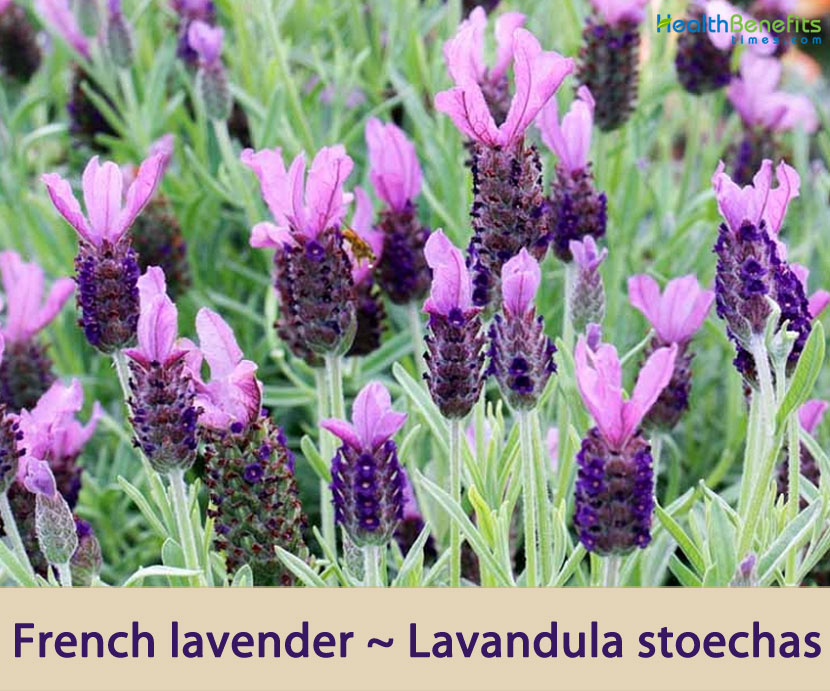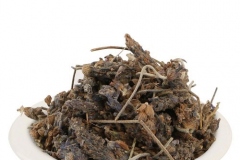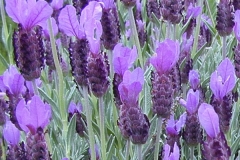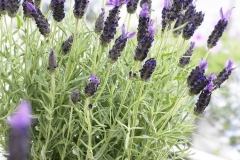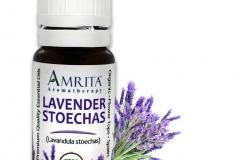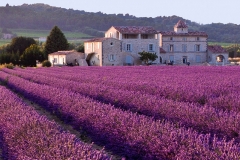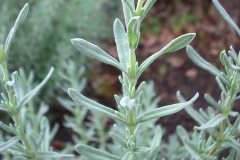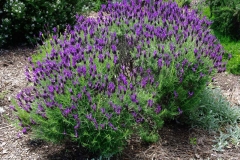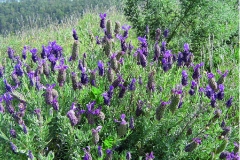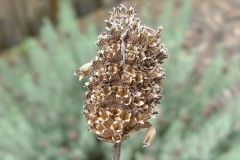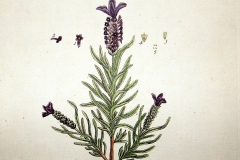| French lavender Quick Facts | |
|---|---|
| Name: | French lavender |
| Scientific Name: | Lavandula stoechas |
| Origin | Northwestern Africa, the Madeira Islands, the Canary Islands, southern Europe, and Western Asia |
| Colors | Green when young turning to brown as they mature |
| Shapes | Schizocarp, brown, woody, dehiscent containing four seeds |
| Taste | Bitter |
| Health benefits | Support abdominal and stomach pain, cough and cold, diabetes, kidney ailments, wounds, sneezing, asthma, bronchitis, rheumatism and lumbago |
| Name | French lavender |
|---|---|
| Scientific Name | Lavandula stoechas |
| Native | Northwestern Africa (i.e. Algeria, Morocco and Tunisia), the Madeira Islands, the Canary Islands, southern Europe (i.e. Greece, Italy, France, Portugal and Spain) and Western Asia (i.e. Cyprus, Israel, Lebanon, Syria and Turkey). It has been introduced throughout Europe and to temperate/sub temperate areas in the Americas, Asia and Australia |
| Common Names | Arabian Lavender, Bush Lavender, Butterfly Lavender, Common French Lavender, Italian Lavender, Quasti Lavender, Rabbit Ears, Spanish Lavender, Top Lavender, Topped Lavender, wild lavender, Bract Lavender |
| Name in Other Languages | Afrikaans: Haasoor laventel, Spaanse laventel Arabic : Arshameesa, Arshaneesa, Astuhudus, Halhaal, Moqif Rwah, Meharga Sunbul Al-Ahaaniya, Ustookhoodoos, Washa’i Al-Shaikh, daram mukawar (ضرم مكور) Azerbaijani: Yunan lavandası Basque: Izpiliku min Bengali: Tuntuna Berber : Amezzir, Timerza, Imezzir Breton: Lavand-kêr Catalan: Cap d’ase, Tomaní, Tomanyí, bafarull, bofarull, cabeçuda, campdasa, caps de burro, cardigrasses, romaní mascle, timó mascle, Chinese : Xun Yi Cao Corsican: Piumbonu Czech: Levandule korunkatá Danish: Sommerfuglelavendel,Vælsk Lavendel Dutch: Franse Lavendel, Kuifl avendel, Stechas Lavendel, Stechas Sort English: French lavender, Italian lavender, Spanish lavender, Topped lavender, Wild lavender, butterfly lavender Finnish: Tupsupäälaventeli, Ranskanlaventeli, Tupsulaventeli French: Lavande, Lavande Maritime, Lavande Papillon, Lavande Stéchade, Lavande Stéchas, Lavande À Toupet, Stoechas Arabique, lavande des Maures, lavande des Stoechades, lavande des Îles d’Hyères, lavande à fleurs alignées, stéchas, stéchas d’Arabie Galician: Cantroxo German: Ährenförmiger Lavendel, Schopf-Lavendel, Schopflavendel Greek: Agriolevánta (Αγριολεβάντα), Levánta (Λεβάντα), levánta tis Karías (λεβάντα της Καρίας) Gujarati: Lavendara No Phul Hebrew: Azoveyon dagul, אזוביון דגול, אֲזוֹבְיוֹן דָּגוּל Hindi: Dharu Hungarian: Spanyol Levendula, füzéres levendula Italian: Lavanda Di Monte, Lavanda Selvatica, Lavanda Stoechas, Steca, Stecaole, Stigadosso Kabyle: Amezzir Kashmiri: Kale Weouth Netherlands: Stechas Norwegian: Fransk Lavendel Persian : Jarub Dimagh, Ustkhuddus, اسطوخودوس Portuguese: Alfazema, Arçã, Rosmaninho, alfazema-brava, cabeçuda, lavândula, rasmonino, rasmono, rosmano, tomelo Russian: Lavanda stekhadskaya (Лаванда стэхадская) Slovak: Levanduľa hlávkovitá Spanish : Arçã, Astecados, Azaya, Cantahueso, Cantuerca, Cantueso, Cantueso Morisco, Cap D’ase, Estecados, Hierba De San Juan, Lavándula, Romero De Piedra, Romero Santo Tomillo, Tomillo Borriquero, almoraduz de cuello corto, azaya, espliego, flor del Corpus, flor del Señor, lavanda romana, romero de señor, rosmano, timosa, tomillo cantimpalo, tomillo cantueso, tomillo cantueso caballar, tomillo de flor morada, té de moro, lavande à toupet; lavande stéchade Swedish : Skärmlavendel Tunisian Arabic: Halhal (حلحال) Turkish : Karabaşotu, karabaş Urdu: Ustkhuddus Welsh: Lafant |
| Plant Growth Habit | Low-growing but mostly upright, erect, evergreen, perennial shrub |
| Growing Climates | Dry hills, garrigue, maquis shrub land, open woodlands, pastures, roadsides, disturbed sites, gardens, waste areas, waterways, mallee scrublands, lowland grasslands and disturbed grassy woodlands |
| Soil | Needs fast-draining, nutrient-poor, alkaline soil. Occasional pruning will help keep this lavender clean and blooming. This plant prefers poor soil conditions; it does not grow well in nutrient-rich, fertile soils. Gravel mulch is a great option for topping the soil around French lavender |
| Plant Size | Usually less than 60 cm tall, but occasionally reaching up to 1 m in height |
| Stem | Quadrangular, pubescent stems becoming woody and rough with age |
| Leaf | Leaves are greyish-green or silvery in color and softly hairy (i.e. pubescent). These small leaves are 1-3 cm long and 2-5 mm wide and are oppositely arranged along the stems and stalk less |
| Flowering season | May to August |
| Flower | Small tubular flowers are 5-8 mm long and are deep purple in color and are subtended by deep bluish-purple bracts 12-25 mm long. Their sepals are fused into a short tube (i.e. calyx tube) 4-6 mm long with many veins. The five petals are also fused into a tube (i.e. corolla tube) with five spreading lobes (i.e. corolla lobes). Flowers also have four yellow stamens and an ovary topped with a very short style. |
| Fruit Shape & Size | Schizocarp, brown, woody, dehiscent containing four seeds |
| Fruit Color | Green when young turning to brown as they mature |
| Seed | Seeds are about 2 mm across are almost round (i.e. sub-globular) and brown mottled with numerous darker spots |
| Taste | Bitter |
| Propagation | By seed or semi-hardwood cuttings |
| Season | July to September |
| Precautions |
|
Plant Description
French lavender is a low-growing but mostly upright, erect, evergreen, perennial shrub that normally grows less than 60 cm tall, but occasionally reaching up to 1 m in height. The plant is found growing in dry hills, garrigue, maquis shrub land, open woodlands, pastures, roadsides, disturbed sites, gardens, waste areas, waterways, mallee scrublands, lowland grasslands and disturbed grassy woodlands. The plant needs fast-draining, nutrient-poor, alkaline soil. Occasional pruning will help keep this lavender clean and blooming. The plant prefers poor soil conditions; it does not grow well in nutrient-rich, fertile soils. Gravel mulch is a great option for topping the soil around French lavender.
Stems
The stems are upright (i.e. erect or ascending) or occasionally creep along the ground for a short distance and then grow upwards (i.e. decumbent). They are square in cross-section (i.e. quadrangular) and densely covered in greyish-coloured hairs. Older stems are somewhat woody, rougher in texture, and rounded in cross-section.
Leaves
Like the stems, the leaves are greyish-green or silvery in color and softly hairy (i.e. pubescent). These small leaves are 1-3 cm long and 2-5 mm wide and are oppositely arranged along the stems and stalk less (i.e. sessile). They are long and narrow (i.e. linear or lanceolate) with rounded or somewhat pointed tips (i.e. obtuse or sub-acute apices). Their margins are entire, but are usually curved downwards (i.e. recurved).They are highly scented, especially when rubbed.
Flowers
Large numbers of inconspicuous tubular flowers are arranged in dense cylindrical clusters that is 2-5 cm long at the tips of the stems (i.e. in terminal spikes). These flower clusters are borne on stalks (i.e. peduncles) 1-2.5 cm long and are topped with up to five distinctive, purple or violet coloured, petal-like bracts (10-50 mm long). The small tubular flowers are 5-8 mm long and are deep purple in color and are subtended by deep bluish-purple bracts 12-25 mm long. Their sepals are fused into a short tube (i.e. calyx tube) 4-6 mm long with many veins. The five petals are also fused into a tube (i.e. corolla tube) with five spreading lobes (i.e. corolla lobes). Flowers also have four yellow stamens and an ovary topped with a very short style. They give off a strong lavender perfume and flowering occurs from late winter through to summer (i.e. from August to January), but is most apparent during spring.
Fruit
The fruit (i.e. a schizocarp) is brown, woody and splits apart when mature into four seeds (i.e. mericarps or nutlets). These seeds are about 2 mm across are almost round (i.e. sub-globular) and brown mottled with numerous darker spots. They are produced during late spring and early summer.
Traditional uses and benefits of French Lavender
- Polat and Satıl found that Hypericum perforatum, Lavandula stoechas, Salvia tomentosa, Origanum onites , Origanum vulgare and Teucrium polium were the most commonly used plant species for medical purposes by the local people of Edremit Gulf, located in the western region of Turkey.
- The traditional medicinal plants have been mostly used for the treatment of abdominal and stomach pain, cough and cold, diabetes, kidney ailments and wounds.
- French lavender oil is widely used in aromatherapy as a holistic relaxant.
- French lavender decoction is used for catarrh of the upper respiratory tract, sneezing, cough, asthma, bronchitis, abdominal pains, colds, rheumatism, lumbago, etc. in Morocco.
- In the Middle Atlas, North Africa, French lavender is used to aromatize the Lben.
- An infusion of flowering tips is used as a tonic, resolvent, stomachic, vulnerary, diaphoretic, pectoral, diuretic, antispasmodic and anti-rheumatic and for headache, cases of irritability, epilepsy and blenorrhagia.
- Flowers, and the essential oil derived from them, are anti-asthmatic, antiseptic, antispasmodic, digestive, expectorant, healing and antibacterial.
- It is used internally to alleviate nausea.
- Externally, the essential oil is used as an antiseptic wash for wounds, ulcers, sores etc. and as a relaxing oil for massage.
- Flower spikes have been used internally for headaches, irritability, feverish colds and nausea, and externally for wounds, rheumatic pain and as an insect repellent.
- Infusion of its dry inflorescences is febrifuge and fights the affections of the chest and bronchi.
- It strengthens intelligence and memory and relieves mental fatigue and confusion
- It is used in the treatment of most brain disorders in the Arab-Persian tradition.
- It is used in the treatment of sinusitis, cough, chronic cold and feverish cold.
- It prevents and relieves the symptoms of depression and anxiety.
- It is used together with other herbs in the treatment of headache and migraine. Try gently massaging your head using lavender shampoo and conditioner bars in the shower with your next migraine.
- It accelerates blood circulation.
- It prevents vascular occlusion.
- It helps in the treatment of urinary tract infection and vaginal infections.
- It prevents the development of blood cancer and many types of cancer.
- It accelerates the healing of skin wounds.
- It relieves nausea.
- It is good for insomnia.
- It is good for indigestion, constipation and flatulence.
- It regulates the digestive system and makes the intestines work more actively.
- It relieves muscle aches and muscle fatigue.
- It stops the progression of tumors in the brain.
- It prevents skin wrinkles and premature aging of the skin. You can get a smoother skin by gently massaging your skin with 2-3 drops of French Lavender oil daily.
- By disinfecting wounds, it improves the appearance of burns such as sunburns.
- It stops hair loss, contributes to the appearance of more lively and shiny hair. It nourishes the hair and gives a natural shine to the hair.
Culinary Uses
- Lavender flowers can be used both in sweet and savory dishes.
- Delicious lavender sugar can be made with the flowers to add to biscuits, sorbets, jams or jellies.
- Flowers look beautiful and taste good too in a glass of champagne, with chocolate cake, or as a garnish for sorbets or ice creams.
- Diminutive blooms add a mysterious scent to custards, flans or sorbets.
- Flowers can be added to vegetable stock and stews and to create a tasty sauce for duck, chicken or lamb dishes.
- It is used as a culinary herb to prepare a particular type of couscous, to flavor certain traditional meals, and to prepare tea and soup.
- This plant is used in the traditional pharmacopeia to treat headaches, depression, diabetes, and inflammatory and rheumatic diseases in Morocco, Algeria, and Tunisia.
- Essential oils from this plant are recognized to be effective against colic and chest affections and are used to relieve nervous headaches.
- French lavender can be used in making cookies, candies, ice creams and beverages.
Other Facts
- This lavender is grown as a medicinal plant in western India, as an ornamental and for essential oil elsewhere.
- All the forms of lavender including this lavender are much visited by bees and provide good sources of honey.
- From this lavender, an essential oil is extracted and used for air fresheners, deodorants, disinfectants, insecticides, soaps, perfumes and medicines.
- The aromatic leaves and flowers are used in potpourri and as an insect repellent in the linen cupboard.
- After the removal of the flowers for use in potpourri, the flowering shoots can be tied in small bundles and burnt as incense sticks.
- When growing the plant for its essential oil content, it is best to harvest the flowering stems as soon as the flowers have faded.
- They are also used as a strewing herb in churches etc.
- Flowering stems, once the flowers have been removed for use in pot-pourri etc., can be tied in small bundles and burnt as incense sticks.
References:
https://www.itis.gov/servlet/SingleRpt/SingleRpt?search_topic=TSN&search_value=506033#null
https://npgsweb.ars-grin.gov/gringlobal/taxon/taxonomydetail?id=21685
https://pfaf.org/user/Plant.aspx?LatinName=Lavandula+stoechas
http://www.theplantlist.org/tpl1.1/record/kew-109094
https://gd.eppo.int/taxon/LAVST
https://keyserver.lucidcentral.org/weeds/data/media/Html/lavandula_stoechas.htm
https://en.wikipedia.org/wiki/Lavandula_stoechas
https://www.cabi.org/isc/datasheet/29950
https://plants.usda.gov/home/plantProfile?symbol=LAST9


